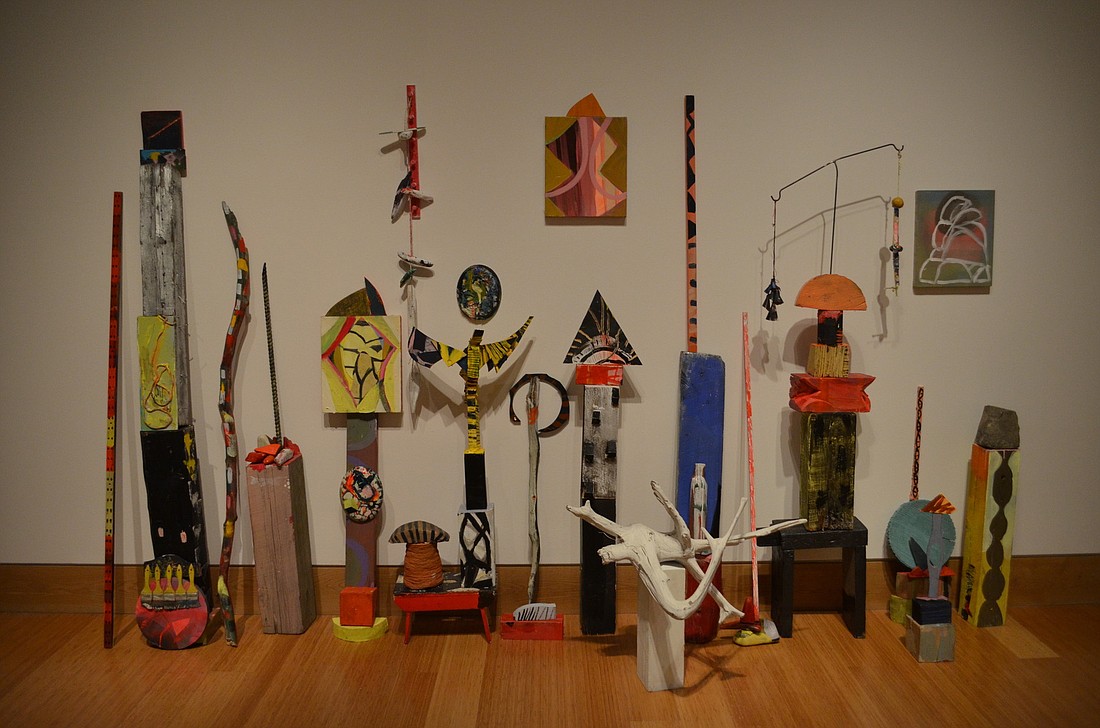- November 24, 2024
-
-
Loading

Loading

The normal rules of art work and museum display are out the window for the newest exhibit at the John and Mable Ringling Museum of Art. Instead of paint, canvas, marble or photography, the “Re:Purposed” exhibit is comprised entirely of objects, materials or things cast off by society. In essence, the colorful and kinetic work living inside the Ringling is made of trash.
One man’s trash is another man’s treasure, well, in this case art. That popular mantra is the ringing theme of “Re:Purposed” which opened at the Ringling this past weekend and runs through May 17. The exhibit is comprised of 10 international contemporary artists: Nick Cave, Aurora Robson, Mac Premo, Jill Sigman, El Anatsui, Alyce Santoro, Vanessa German, Matt Eskuche, Emily Noelle Lambert and Daniel Rozin. And even though every piece is made of repurposed objects thrown away by society, each one reflects the unique perspective of each artist.
According to Matthew McLendon, curator of modern and contemporary art, “Re:Purposed” is an exhibition operating on three separate levels: identity, index and environment. “The notion of identity reflects the personas created through property used in each piece,” says McLendon. “Nick Cave constructs new identities through his Soundsuits which erase race, class and gender and allow the wearer to create a completely new persona.”
Index, the second thematic level of the exhibition, reflects how each piece of cast off material has its own unique biography. Through their personal journeys from their creation, trash to this exhibit, they have had an evolving narrative through changing contexts. And environment, the third level of the exhibit, is the most approachable and natural reaction to the works that without these artists’ efforts would be sitting at the bottom of a landfill.
One artist that reflects the impact of thousands upon thousands of discarded items specifically in the Sarasota area is featured artist Jill Sigman. Her “Hut #10” piece is a full-sized one room domicile with a complete roof and porch that is constructed entirely of trash and objects she found while in Sarasota. Sigman scoured the Ringling property, local neighborhoods, and the local waste management relocation center to create her newest hut. “Every hut has been different and a representation of that places,” says Sigman, who was adding the final touches on her piece before the exhibit opened. “You learn a lot about a place when you see what they throw away and why.” For modern art lovers apprehensive about walking around and under Sigman’s intricate trash architecture, the Sigman and the Ringling staff took every precaution to insure zero contamination. According to McLendon, each piece used in “Hut #10” was sorted, vacuumed, quarantined and frozen at minus 22 degrees Celsius for one week.
In addition to Cave’s colorful suits and Sigman’s organic hut fixture, each artist brings a singular vision to the use of cast off items. Of particular note are Emily Noelle Lambert’s sculpture works and Daniel Rozin’s “Trash Mirror.” Lambert’s work plays with the idea of artistic from by combining large cast off items combined as the canvas for individual paintings. “This all started in 2002 at the Guggenheim Museum when I was a teaching artist,” says Lambert. “I taught students to create creatures out of found objects.” And from there Lambert composed a variety of three-dimensional canvases to apply her painter’s voice. “In my studio, it’s like a soup,” says Lambert. “So much is happening.”
And against the wall in the middle of the gallery space is Rozin’s interactive piece “Trash Mirror.” Composed of dozens of individual panels adorned with a piece of trash, the entire wall is motion sensitive and is triggered by anyone walking in front of it. The movement sensor then powers motors that tilt each individual panel to correspond with the shape of the person walking in front of Rozin’s machine. It all results in a mirror that outlines patrons’ figures with each panel of trash acting as a pixel on a screen. Rozin’s work illuminates the universal message of “Re:Purposed,” the millions of objects discarded by humanity is a reflection, good and bad, on society